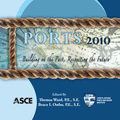Piers 6 and 31 Replacement—Evolution of Design
Publication: Ports 2010: Building on the Past, Respecting the Future
Abstract
The Piers 6 and 31 Replacement projects for the US Navy at Naval Submarine Base New London (SUBASE) in Groton, Connecticut replaced outdated piers with modern piers suitable for double berthing multiple classes of nuclear submarines. Pier 6 was designed as the prototype pier for the new Virginia Class of submarines. The design was based on Unified Facilities Criteria (UFC) 4-152-01, Piers and Wharfs, which was under development at the time. Pier 31 incorporated design and construction lessons-learned from the Pier 6 project, resulting in a more refined design. Each 67 foot wide by 500 foot long (20m wide x 150m long) pier consists of reinforced concrete deck and supporting beams. The piers' rigid-frame foundations consist of concrete pile caps supported by concrete-filled steel pipe piles, which are secured to bedrock via rock sockets. Top priorities for the Navy were providing a flexible layout that would allow multiple operations to be conducted on multiple submarines without restricting pier access; and utilizing low-maintenance materials to decrease life-cycle costs and facility down-time. These requirements were incorporated into the designs by providing wide, unobstructed deck layouts with utilities located in trenches below the deck surface. The fender system features low- maintenance composite materials and allows the flexibility of mooring various classes of submarines or smaller craft. Utility standpipes were located on shore to further minimize congestion on the pier. The steel pipe piles include a protective coating, passive cathodic protection, and fiberglass jackets in the splash zone. In addition, telescoping "crane-less" aluminum personnel brows were provided on the piers to minimize the need for truck crane operations. Pier 31 incorporated several improvements on the Pier 6 design: marine concrete was used throughout the pier; the pile design was refined to account for an increase in pile lengths; utility vaults were located at pier expansion joints to simplify utility expansion joints; and the trench covers were designed to support the truck crane outrigger loads. The design efforts described in this paper will be of interest and benefit to conference attendees since the new Pier 6 and Pier 31 facilities exemplify a new generation of modern Navy submarine piers that successfully meet operating and maintenance initiatives, conform with the latest Navy pier design criteria, and employ innovative design concepts and materials to create a multifunctional structure that will serve the Navy well into the future.
Get full access to this article
View all available purchase options and get full access to this chapter.
Information & Authors
Information
Published In
Copyright
© 2010 American Society of Civil Engineers.
History
Published online: Apr 26, 2012
ASCE Technical Topics:
- Building design
- Concrete piles
- Design (by type)
- Engineering fundamentals
- Foundations
- Geotechnical engineering
- Hydraulic engineering
- Hydraulic properties
- Hydraulic structures
- Infrastructure
- Lifeline systems
- Piers
- Pile foundations
- Piles
- Pipe piles
- Pipeline systems
- Pipes
- Ports and harbors
- Steel piles
- Steel pipes
- Submerging
- Utilities
- Water and water resources
Authors
Metrics & Citations
Metrics
Citations
Download citation
If you have the appropriate software installed, you can download article citation data to the citation manager of your choice. Simply select your manager software from the list below and click Download.
